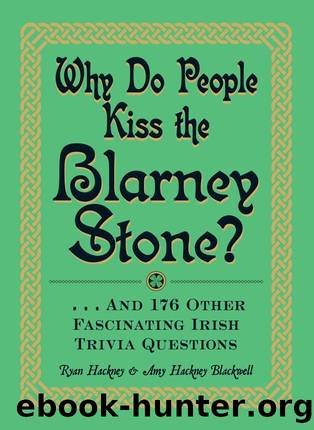Why Do People Kiss the Blarney Stone? by Ryan Hackney & Amy Hackney Blackwell

Author:Ryan Hackney & Amy Hackney Blackwell [Blackwell, Amy Hackney; Hackney, Ryan]
Language: eng
Format: epub
ISBN: 9781440560064
Publisher: Adams Media
Published: 2013-07-15T00:00:00+00:00
PART 8
The Irish Potato Famine
An Gorta Mór, the Great Potato Famine of the 1840s, is one of the pivotal events in Irish history. Millions emigrated, and the resulting demographic shift led to a decreasing population. The famine also ignited anger at the British government, which eventually grew into the Irish independence movement. How could the simple spud cause so much trouble? Let’s see how much you know!
WHAT CAUSED THE GREAT POTATO FAMINE?
Potatoes came to Europe from the New World in the early sixteenth century. Sir Francis Drake is thought to have introduced the potato to England, and shortly afterward Sir Walter Raleigh tried planting them on his Irish estates.
When potatoes reached Ireland, they created a revolution. They were very easy to grow; farmers could plant them in the spring and leave them alone for months while they went off and worked elsewhere (anywhere that scarce wages might be offered). People grew potatoes on any patch of land that could sustain them, even the most marginal of fields.
Potatoes are extremely nutritious; they are full of vitamins, protein, calcium, and iron, especially when washed down with buttermilk, the potato’s traditional accompaniment. The potato, in fact, is perhaps the only crop that can provide a balanced diet by itself, which kept the Irish healthier than other people living on one starch such as rice or millet or even bread (made of wheat). It was relatively easy to store over the winter, which was important because most tenant farmers had no buildings in which to store vast quantities of grain. Unfortunately, you can’t store potatoes for much more than a year, and this would have devastating consequences for the Irish in the famine years.
Patterns in land ownership made Irish farmers dependent on the potato. Most farmers had to rent from landlords (who were usually English) who demanded cash payments. The farmers had to use most of their time and land to produce cash crops to cover the rent, and consequently they only had small amounts of time or land left to grow their own food. Given these constraints, the potato was the only crop that could provide sufficient nutrition to feed the growing Irish families.
So there the Irish were, planting their potatoes every spring, digging them up every fall, and eating rather well, all things considered. But in the autumn of 1845, all that changed.
In October of that year, farmers walked out to their fields to harvest their crops. They plunged their shovels into the ground and then shrieked in horror—the potatoes were black and rotten, completely useless. The crop they had counted on for generations had finally failed them.
No one knew what to do. Experts offered advice, suggesting that the fungus killing the potatoes was attracted to moisture. Farmers tried to dig dry pits, but the spores traveled through the air and soaked into the ground after the rain, which has always been plentiful in Ireland. It took only one infected plant to spread the blight over acres of potatoes. There was no escape.
Download
This site does not store any files on its server. We only index and link to content provided by other sites. Please contact the content providers to delete copyright contents if any and email us, we'll remove relevant links or contents immediately.
| Africa | Americas |
| Arctic & Antarctica | Asia |
| Australia & Oceania | Europe |
| Middle East | Russia |
| United States | World |
| Ancient Civilizations | Military |
| Historical Study & Educational Resources |
Room 212 by Kate Stewart(4107)
The Crown by Robert Lacey(4105)
Endurance: Shackleton's Incredible Voyage by Alfred Lansing(3845)
The Iron Duke by The Iron Duke(3639)
The Rape of Nanking by Iris Chang(3516)
Killing England by Bill O'Reilly(3455)
Joan of Arc by Mary Gordon(3259)
Say Nothing by Patrick Radden Keefe(3060)
I'll Give You the Sun by Jandy Nelson(2842)
Hitler's Monsters by Eric Kurlander(2732)
Shadow of Night by Deborah Harkness(2718)
Margaret Thatcher: The Autobiography by Thatcher Margaret(2684)
Mary, Queen of Scots, and the Murder of Lord Darnley by Alison Weir(2678)
Darkest Hour by Anthony McCarten(2646)
Blood and Sand by Alex Von Tunzelmann(2608)
Red Famine: Stalin's War on Ukraine by Anne Applebaum(2463)
Eleanor & Park by Rainbow Rowell(2393)
The One Memory of Flora Banks by Emily Barr(2348)
Book of Life by Deborah Harkness(2263)
